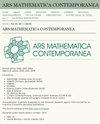一类三次图的完美匹配、哈密顿循环和边着色
IF 0.9
3区 数学
Q3 MATHEMATICS
引用次数: 0
摘要
图G具有完美匹配-哈密顿性质(pmh性质),如果对于它的每一个完美匹配,有另一个G的完美匹配,使得两个完美匹配的并并产生G的哈密顿循环。具有pmh性质的图的研究,在20世纪70年代由Las Vergnas和Häggkvist发起,结合了图的三个被充分研究的性质,即匹配,哈密顿性和边着色。在这项工作中,我们研究了三次图的这些概念,试图描述那些每一个完美匹配对应于图的适当三边着色的颜色之一的三次图。我们讨论这等价于说这样的图是偶2因子(E2F),即图的所有2因子只包含偶环。二部三次图的情况是平凡的,因为如果G是二部的,那么它是E2F。因此,我们将注意力限制在非二部三次图上。三次图是E2F的一个充分但非必要的条件是它具有pmh性质。本文的目的是在两个参数上引入无限族的E2F非二部三次图,并确定这些图具有pmh性质或仅为E2F的相应参数的值。我们还证明了没有两个具有不同参数的papillon图是同构的。本文章由计算机程序翻译,如有差异,请以英文原文为准。
Perfect matchings, Hamiltonian cycles and edge-colourings in a class of cubic graphs
A graph G has the Perfect-Matching-Hamiltonian property (PMH-property) if for each one of its perfect matchings, there is another perfect matching of G such that the union of the two perfect matchings yields a Hamiltonian cycle of G. The study of graphs that have the PMH-property, initiated in the 1970s by Las Vergnas and Häggkvist, combines three well-studied properties of graphs, namely matchings, Hamiltonicity and edge-colourings. In this work, we study these concepts for cubic graphs in an attempt to characterise those cubic graphs for which every perfect matching corresponds to one of the colours of a proper 3-edge-colouring of the graph. We discuss that this is equivalent to saying that such graphs are even-2-factorable (E2F), that is, all 2-factors of the graph contain only even cycles. The case for bipartite cubic graphs is trivial, since if G is bipartite then it is E2F. Thus, we restrict our attention to non-bipartite cubic graphs. A sufficient, but not necessary, condition for a cubic graph to be E2F is that it has the PMH-property. The aim of this work is to introduce an infinite family of E2F non-bipartite cubic graphs on two parameters, which we coin papillon graphs, and determine the values of the respective parameters for which these graphs have the PMH-property or are just E2F. We also show that no two papillon graphs with different parameters are isomorphic.
求助全文
通过发布文献求助,成功后即可免费获取论文全文。
去求助
来源期刊

Ars Mathematica Contemporanea
MATHEMATICS, APPLIED-MATHEMATICS
CiteScore
1.70
自引率
0.00%
发文量
45
审稿时长
>12 weeks
期刊介绍:
Ars mathematica contemporanea will publish high-quality articles in contemporary mathematics that arise from the discrete and concrete mathematics paradigm. It will favor themes that combine at least two different fields of mathematics. In particular, we welcome papers intersecting discrete mathematics with other branches of mathematics, such as algebra, geometry, topology, theoretical computer science, and combinatorics. The name of the journal was chosen carefully. Symmetry is certainly a theme that is quite welcome to the journal, as it is through symmetry that mathematics comes closest to art.
 求助内容:
求助内容: 应助结果提醒方式:
应助结果提醒方式:


